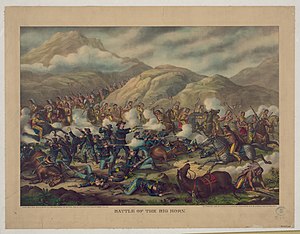Our website is made possible by displaying online advertisements to our visitors.
Please consider supporting us by disabling your ad blocker.
Great Sioux War of 1876
| The Great Sioux War of 1876 | |||||||
|---|---|---|---|---|---|---|---|
| Part of the Sioux Wars and American Indian Wars | |||||||
 Custer's last stand at Little Bighorn in the Crow Indian Reservation | |||||||
| |||||||
| Belligerents | |||||||
| Commanders and leaders | |||||||
| Casualties and losses | |||||||
| 300+ killed | 265 killed | ||||||
The Great Sioux War of 1876, also known as the Black Hills War, was a series of battles and negotiations that occurred in 1876 and 1877 in an alliance of Lakota Sioux and Northern Cheyenne against the United States. The cause of the war was the desire of the US government to obtain ownership of the Black Hills. Gold had been discovered in the Black Hills, settlers began to encroach onto Native American lands, and the Sioux and the Cheyenne refused to cede ownership. Traditionally, American military and historians place the Lakota at the center of the story, especially because of their numbers, but some Native Americans believe the Cheyenne were the primary target of the American campaign.[7]
Among the many battles and skirmishes of the war was the Battle of the Little Bighorn; often known as Custer's Last Stand, it is the most storied of the many encounters between the US Army and mounted Plains Indians. Despite the Indian victory, the Americans leveraged national resources to force the Indians to surrender, primarily by attacking and destroying their encampments and property. The Great Sioux War took place under US Presidents Ulysses S. Grant and Rutherford B. Hayes. The Agreement of 1877 (19 Stat. 254, enacted February 28, 1877) officially annexed Sioux land and permanently established Indian reservations.
- ^ "Great Sioux War of 1876 – Legends of America".
- ^ "The End of the Great Sioux War | History Today".
- ^ Kappler, Charles J. Indian Affairs. Laws and Treaties. Vol. 2. Washington, 1904, pp. 1008–1011. Treaty with the Crows, May 7, 1868.
- ^ Dunlay, Thomas W. Wolves for the Blue Soldiers: Indian Scouts and Auxiliaries with the United States Army, 1860–90. Lincoln and London, 1982. P. 113.
- ^ Hoxie, Frederick E. Parading Through History: The Making of the Crow Nation in America, 1805–1935. Cambridge, 1995. p. 108 and map p. 99.
- ^ Medicine Crow, Joseph. From the Heart of the Crow Country: The Crow Indians' Own Stories. New York, 1992. Map facing p. xxi.
- ^ Liberty, Margot (2006). "Cheyenne Primacy: The Tribes' Perspective As Opposed To That Of The United States Army; A Possible Alternative To 'The Great Sioux War Of 1876'". Friends of the Little Bighorn. Retrieved January 13, 2008.
Previous Page Next Page


